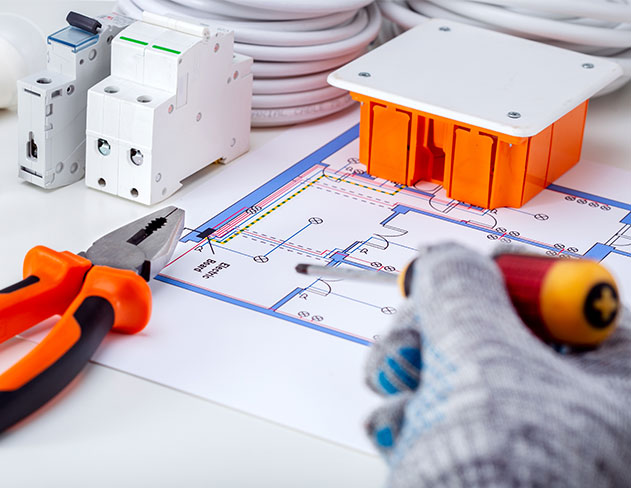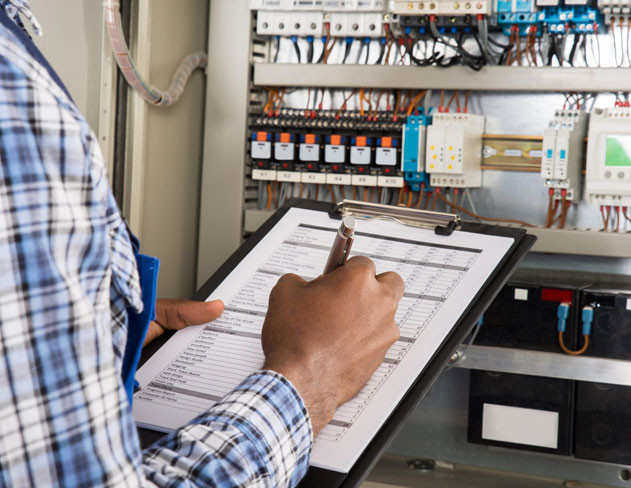EICR Pre-Inspection Checklists for Landlords
Pre-EICR Checklist For Our Customers

Whether you’re a landlord, a homeowner or a business operator, an EICR is essential to ensure your premises adhere to the highest safety standards. EICR Pre-Inspection Checklists for Landlords is a to-do list for before the electrician arrives on your premises. There are a number of things you can do to make sure things go as quickly and smoothly as possible, we have provided an EICR checklist for each customer type below.
Why is an EICR Checklist Necessary?
An EICR checklist serves as a comprehensive guide for both the electrician conducting the inspection and the property owner. It ensures that all necessary points are inspected and tested, leaving no room for oversight. This checklist is especially beneficial for property owners as it provides a clear understanding of what the inspection entails, enabling them to prepare their premises adequately for the inspection.
EICR Checklist for Domestic Properties
As a homeowner, preparing for an EICR involves several steps:
- Identify the Electrical Points: Start by identifying all the electrical points in your property. This includes sockets, switches, light fixtures, and any other hardwired electrical appliances.
- Clear Access to Electrical Points: Ensure the electrician has full access to all these points. This might involve moving furniture or other obstructions. Pay special attention to any points that are usually hidden, like those behind appliances or furniture.
- Check for Visible Damage: Before the inspection, check all your electrical points for any visible damage. This includes damaged fittings, exposed wires, or signs of burning or overheating. Make a note of these points to inform the electrician.
- Fuse Board Preparation: If possible, label your fuse board to indicate which switches correspond to which circuits in your property. This will make the inspection process smoother and more efficient.
- Document Previous Electrical Work: If you’ve had any electrical work done in your property, have the details at hand. This includes any certificates or reports you received. This information can be useful for the electrician conducting the EICR.
Book your domestic EICR today.
EICR Checklist for Business Premises
For business premises, the EICR checklist includes additional points due to the larger scale and complexity of commercial electrical systems:
- Identify Electrical Points: Similar to residential properties, start by identifying all electrical points in your premises. This includes not only sockets and switches but also machinery, equipment, and any other devices that use electricity.
- Ensure Accessibility: Make sure the electrician has full access to all these points. This might involve moving equipment or clearing areas that are usually crowded.
- Check for Visible Damage: Inspect all your electrical points for visible damage. This includes damaged fittings, exposed wires, or signs of burning or overheating. Make a note of these points to inform the electrician.
- Fuse Board and Circuit Breaker Preparation: Label your fuse board and circuit breakers, if possible, to indicate which switches correspond to which circuits in your premises. This will help the electrician conduct a more efficient inspection.
- Document Previous Electrical Work: If your premises have undergone any electrical work, have the details ready. This includes any certificates or reports you received. This information can be useful for the electrician conducting the EICR.
- Plan for Downtime: Depending on the size of your premises, an EICR can take several hours. Plan for this downtime to minimise disruption to your business operations. Get your employees to ‘work from home’ for the day.
Book an EICR for your commercial premises today.
EICR Pre-Inspection Checklists for Landlords
As a landlord, you have a legal responsibility to ensure the electrical safety of your rental properties. Here’s how you can prepare for an EICR:
- Understand Your Properties: Different types of properties may have different electrical needs. A single-family home will have different considerations than a multi-unit apartment building or a commercial property. Understand the specific electrical systems of each property type you manage.
- Inform Your Tenants: Notify your tenants well in advance about the scheduled EICR. They have a right to know when and why someone will be entering their living space.
- Access to All Areas: Ensure the electrician has access to all areas of the property, including tenant living spaces, common areas, utility rooms, and any other areas with electrical installations.
- Check for Visible Damage: Inspect all your electrical points for visible damage. This includes damaged fittings, exposed wires, or signs of burning or overheating. Make a note of these points to inform the electrician.
- Fuse Board and Circuit Breaker Preparation: Label your fuse board and circuit breakers, if possible, to indicate which switches correspond to which circuits in your premises. This will help the electrician conduct a more efficient inspection.
- Document Previous Electrical Work: If your premises have undergone any electrical work, have the details ready. This includes any certificates or reports you received. This information can be useful for the electrician conducting the EICR.
- Plan for Downtime: Depending on the size of your property, an EICR can take several hours. Plan for this downtime to minimise disruption to your tenants.
Next Steps After The EICR Inspection
Once the EICR inspection is complete, you will receive a detailed report outlining the condition of your electrical installations. Here’s what you should do next:
- Review the Report: The EICR report will classify issues into different codes, indicating the severity of each issue. Code C1 means ‘Danger present’, C2 means ‘Potentially dangerous’, C3 means ‘Improvement recommended’, and FI means ‘Further Investigation’ required. Familiarise yourself with these codes to understand the urgency of required repairs.
- Address Identified Issues: Any issues classified as C1 or C2 or FI are serious and should be addressed immediately. Even C3 issues, while not immediately dangerous, should be fixed to ensure the long-term safety of your electrical installations.
- Retesting After Repairs: After necessary repairs are made, a retest will be conducted to ensure the safety of the electrical installations. This is usually a much quicker process, focusing only on the areas that were initially problematic.
- Regular Inspections: An EICR is not a one-time process but should be part of your regular property maintenance. For homeowners, an EICR is recommended every 10 years or whenever you move into a new property. For landlords, an EICR should be conducted every 5 years or with each change of tenancy. For businesses, the frequency of EICR depends on the type of business but is usually recommended every 1 to 5 years.
Remember, electrical safety is not a one-time task but an ongoing responsibility. Regular inspections and prompt repairs are essential to maintaining your property’s safety and its occupants’ well-being.
Ready to schedule your EICR inspection? At Hexo Electrical Testing, our team of qualified electricians is ready to ensure your property’s electrical safety. Book an EICR for your London property today.

